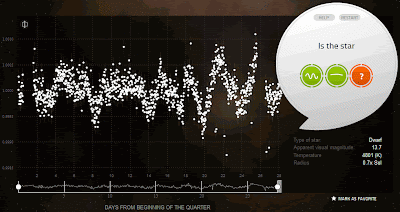 It is only after classifying a star that you get to know its designation. This one is APH23088897, a small star, probably spectral type K5, based on the temperature of 4800K. You'll need to click on the image to read the particulars.
It is only after classifying a star that you get to know its designation. This one is APH23088897, a small star, probably spectral type K5, based on the temperature of 4800K. You'll need to click on the image to read the particulars.I decided to capture this as about the most average star I've seen, though that depends a lot on what you mean by "average". The Sun is often called an average star, though more than 90% of all stars are smaller and dimmer. But those that are larger range up to 100 times as massive and millions of times as luminous, while the smallest true stars of type M8 or M9 (some folks call M9 the beginning of brown dwarfs) are about one-twelfth the mass of the Sun and very faint. The arithmetic mean of such a distribution is meaningless, but the logmean—the average of the logarithms—is useful. My rough calculation would make a K5 star very close to "average".
Another thing that is hard to average out is the steadiness of the luminosity. This star is slightly variable, with a luminosity range of about a fifth of a percent. This is actually similar to the Sun's range of brightness due to varying sunspot numbers over a period of a few days. Many of the stars I see in Planet Hunters are very steady, with variations less than one in ten thousand, though the precision of recording the brightness is not at that level due to statistical photon noise. The various ways a star can be variable make an average variability quite moot. It is like the rainbow: What is the average color?
So far I have classified nearly 3,800 stars. My current rate is rather low; I spend less time on this computer over all than I did a few months ago. According to some scuttlebutt in the blogs, a few people have classified tens of thousands. The thousands of citizen scientists who are doing this have produced more than 2.6 million classifications to date, and the Kepler team has identified 69 potential planets so far among these data; this is in addition to many found by software methods alone. Humans see things computers don't so both methods are yielding unique findings.



No comments:
Post a Comment